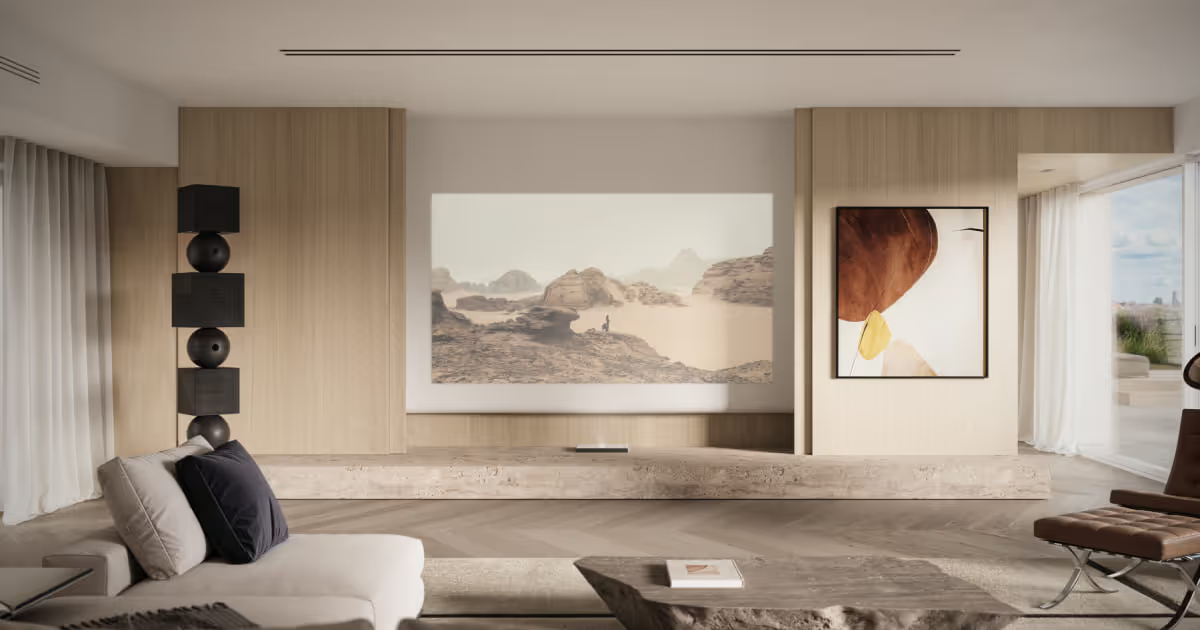3D real estate rendering transforms blueprints into experiences. It's the process of creating photorealistic digital images that make unbuilt properties feel tangible, breathing life into architectural plans through the alchemy of light, texture, and perspective.
Morning light pours through windows that exist only in code, casting shadows that shift with algorithmic precision across materials that haven't been manufactured yet. Spaces come alive before they're born.
Those technical drawings and basic models served their purpose, but they required translation, demanding that buyers decode and imagine human-scale experiences from bird's-eye abstractions.
They asked buyers to take a leap of faith, squinting at abstract lines and measurements, trying desperately to see themselves in spaces that didn't exist, attempting to feel the warmth of a kitchen that was merely a rectangle on paper.
What started as a tool for architects has become the primary language between developers and buyers.
Here's what's happening: properties are being sold before they exist, with buyers confidently making six-figure decisions based on digital experiences that feel more real than reality itself. All of our projects, including West End Trattoria, Hotel Las Vegas, and several others were sold before they were built.
Investors write checks for buildings they've toured in virtual space. Design decisions happen in the digital realm before concrete is poured, saving millions in potential change orders and construction delays that once plagued the industry.
But here's what most miss: 3D rendering isn't disrupting real estate; it's revealing what real estate always was. A business of imagination. Of future-casting.
The difference? Now we can share that imagination with pixel-perfect clarity. The industry hasn't changed.
Our ability to communicate has.
Services That Sell Properties Before They're Built
We've watched this shift take hold. 3D real estate rendering isn't an upgrade.
It's a rewrite.
Services That Sell Properties Before They’re Built
There was a time when vision alone was enough.
A development could be sold from a simple napkin sketch, a floor plan scribbled over lunch, a layout imagined rather than experienced.
But the market has evolved. So have buyers.
Today, they expect more. They expect immersion, precision, and emotional clarity. They have seen photorealistic renderings that evoke morning light and quiet ambience. They have toured entire properties before the first shovel meets the ground. Once that level of realism is experienced, there is no returning to abstraction.
3D real estate rendering is no longer an enhancement.
It is a rewrite.
A shift in how properties are sold, how trust is built, and how stories are told.
We have watched this transformation unfold across every scale of development. The old reliance on interpretation has been replaced by visual certainty. Buyers want to feel how a space lives and breathes before it exists. Atmosphere matters. Detail matters. The standard has been raised, and it is here to stay.
Our project with Alpine proved the power of that shift. The entire development sold out within a month of pre-sale, driven solely by rendered materials. No physical walkthroughs. Just flawless visualization, executed with intention.
Today, renderings are not peripheral. They are central to strategy and experience. They are the connective tissue between architects, developers, and future residents. And when done with care, they do more than show a space; they reveal its soul.
What the research says
Neuroscience shows our brains process visual information up 600 times faster than text. Additionally, according to Newman et al., we don't just process images faster; we trust them more. A rendering doesn't just show a space. It creates a memory of a future that hasn't happened yet. And memories, even false ones, drive decisions more powerfully than logic ever could.
Understanding this leads to practical questions: How do you implement 3D rendering effectively? What are the different approaches, and when should you use each one?
Pre-Construction: Where Magic Happens
Perhaps nowhere is 3D rendering more transformative than in pre-construction sales, where developers must sell the promise of a property that exists only on paper.
Think about the old way. Developers showed blueprints. Scale models. Maybe some artistic sketches. Buyers squinted. Imagined. Hoped they understood what they were buying.
Most didn't.
3D visualization changed the game completely. Buyers understand how spaces flow.
No more decoding blueprints. No more leaps of faith. Buyers see detailed, believable views from every angle.
But here's where it gets interesting.
3D rendering makes customization visual. Buyers see different cabinet styles in their actual kitchen. They compare flooring options in real-time. They participate in creating their future home.
Design flaws reveal themselves early. That awkward corner? It shows. The kitchen island that blocks traffic? Obvious. These discoveries happen in pixels, not concrete.
3D rendering brings clarity to pre-construction sales. It builds confidence. Reduces buyer's remorse. Accelerates decisions. Smart developers know this isn't just marketing; it's transformation.
According to the National Association of Realtors, 31% of buyers' agents say virtual staging is equally important to virtual tours. Even more compelling: 40% of buyers are more willing to walk through a home they saw staged online.
The applications of 3D rendering extend far beyond individual property sales.
Why CGI Wins
The power of 3D rendering becomes clear when you examine its comprehensive impact on real estate marketing and sales processes.
First: communication clarity. Everyone sees the same vision. Developers, architects, contractors, buyers. No translation needed. Misunderstandings vanish when everyone's looking at photorealistic renderings.
Teams iterate faster. Feedback becomes specific. "Make the lobby brighter" becomes "Add these light fixtures here." Changes happen in hours, not weeks.
The economics surprise people.
Building in-house capabilities? Expensive. Software licenses, powerful workstations, endless training. Outsourcing to specialists costs less and delivers more.
Time savings compound. Virtual changes prevent physical mistakes. Catching design issues early saves fortunes.
Specialized firms bring expertise you can't replicate. They've solved every rendering challenge. They know which angles sell. Their investment in technology shows in every pixel.
CGI enables creativity. Show the same space as an office and nursery. Demonstrate seasonal changes. Let buyers customize finishes in real-time.
Property developers treating 3D rendering as a mere expense miss the point. It's a strategic asset. A competitive advantage.
Making informed decisions about 3D rendering requires understanding what drives pricing.
What Drives the Price
To make strategic decisions about 3D rendering investments, you need to understand what drives pricing in this specialized field.
Complexity leads the list.
An entire development with retail and landscaping? Different math entirely.
Quality tiers exist for a reason. Concept renderings are built to communicate direction, to show intent and structure. Marketing renderings are designed to sell a vision, to create emotional pull before a space is even real. The distinction isn’t subtle. It shows up in texture, lighting, composition, and atmosphere.
Resolution is one of the biggest drivers of visual impact. Standard HD may suffice for websites or email campaigns, but high-end print and large-format displays demand the clarity of 4K resolution or higher. That level of precision ensures architectural accuracy and avoids the flatness or pixelation seen in lower resolutions.
At our studio, we deliver all renderings in 4K by default - without any upcharge. It’s simply the standard we hold ourselves to. High quality is not an extra. It’s the baseline.
The tools behind the scenes are also a factor. Professional software licenses can cost thousands of dollars per user. Hardware requirements are intense, and render farms, whether in-house or cloud-based, consume significant amounts of electricity. These are not optional upgrades; they are baseline requirements for producing work that holds up under scrutiny.
A standard rendering timeline is around two weeks. If a client needs something by Monday, it usually means weekend hours. If they need it overnight, it may involve shift work or full-team coordination across time zones. Rush pricing exists for a reason; it reflects the compression of that production schedule and the people needed to make it happen.
The hidden factor? Revisions. Clear briefs save money. Vague direction costs iterations. Smart clients invest upfront in clarity.
Frequently Asked Questions
What is 3D real estate rendering?
3D real estate rendering is the process of creating lifelike digital images or animations of properties that haven’t been built yet. It helps buyers visualize and emotionally connect with a space before it's real.
How does 3D rendering help sell properties faster?
Renderings help buyers visualize layouts, lighting, and finishes. This reduces hesitation, boosts emotional certainty, and accelerates purchase decisions, especially in pre-construction sales.
Can 3D renderings reveal design issues early?
Yes. They help teams identify layout flaws, poor lighting, or awkward features before construction begins, saving time and reducing change-order costs.



